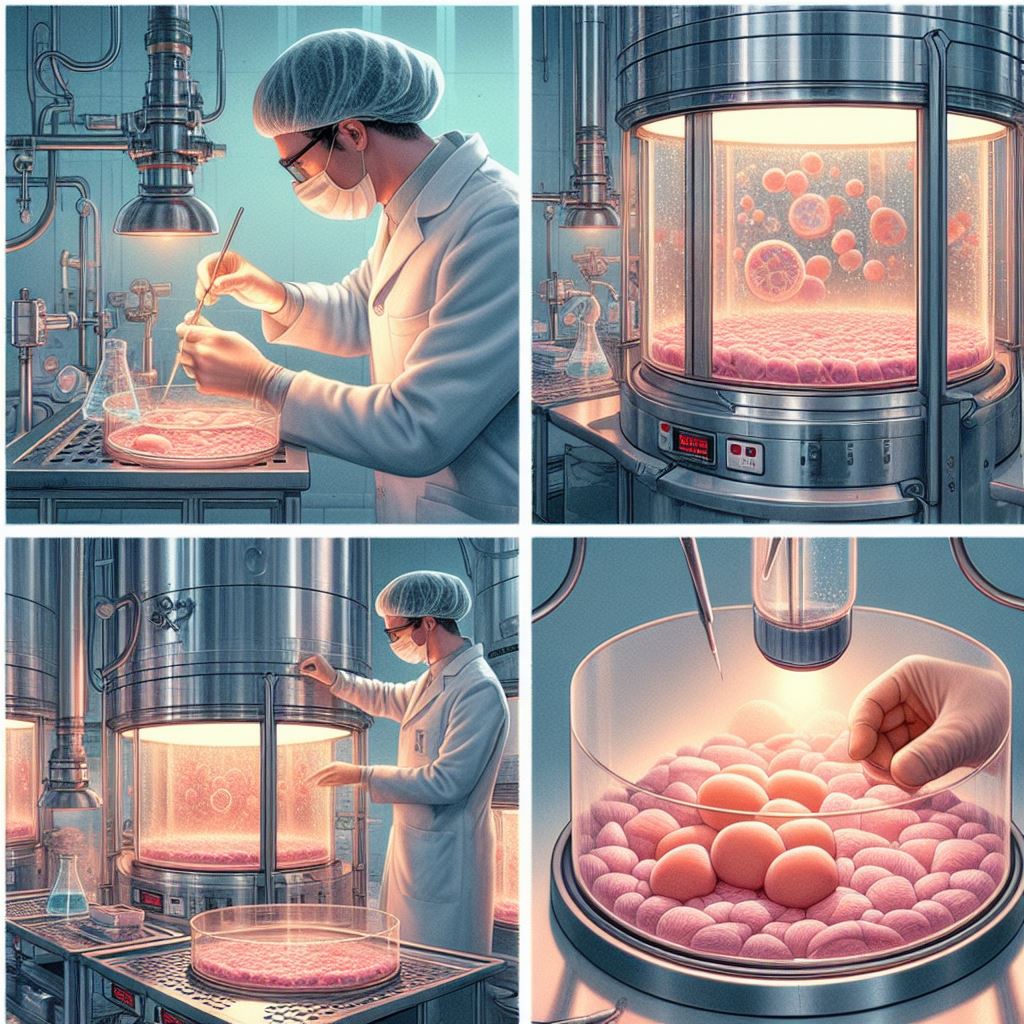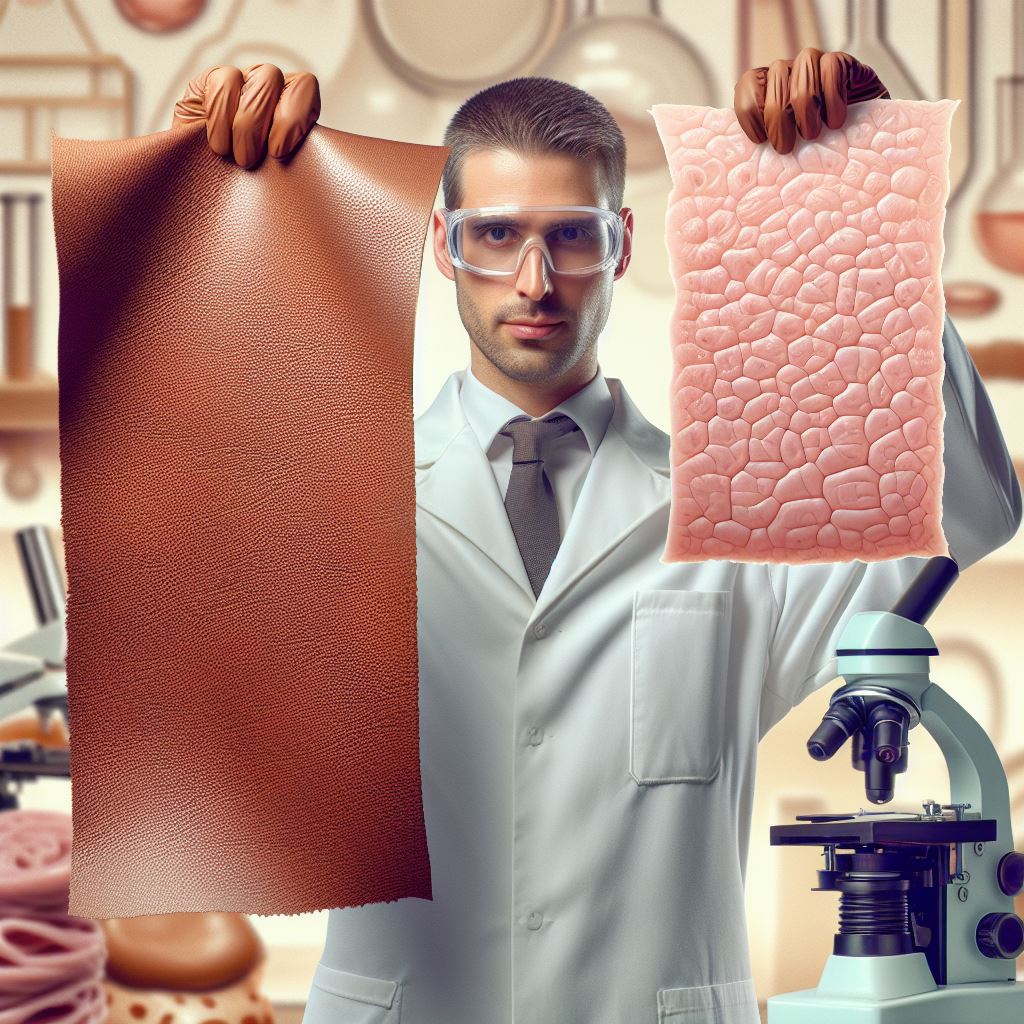Lab-Grown Meat: A Sustainable Solution for Meat Production
Did you know that raising livestock contributes 14.5% of global greenhouse gas emissions? That’s more than all the emissions from transportation combined! As meat lovers ourselves, this stat raises a serious question: can we continue to indulge in our favorite dishes without leaving a massive ecological footprint?
Enter the world of lab-grown meat, also known as cultured meat. Imagine juicy steaks, sizzling burgers, and flavorful sausages – all created without raising a single animal. Sounds like science fiction, right? But this revolutionary technology is rapidly turning from a futuristic dream into a delicious reality.

Lab-grown meat isn’t some plant-based substitute. It’s actual meat, grown from animal cells in a controlled environment. No slaughterhouses, no deforestation for grazing land – just pure innovation on a plate.
Prepare to have your carnivorous curiosity piqued! In this blog post, we’ll delve into the fascinating science behind lab-grown meat, explore its potential to transform the food industry and answer all your burning questions about this game-changing technology. Buckle up, meat lovers, because the future of your favorite meals might be surprisingly delicious and sustainable!
What is Lab-Grown Meat?
Lab-grown meat, or cultured meat, isn’t some futuristic fantasy. It’s a revolutionary technology poised to disrupt the food industry by offering real meat produced entirely outside of an animal. But how exactly does science conjure up a juicy steak without needing a farm? Let’s delve into the fascinating process behind this innovation.

From Animal to Lab: Sourcing the Building Blocks
The journey begins with a tiny sample of animal tissue, usually muscle. Scientists extract muscle stem cells, which have the remarkable ability to develop into mature muscle cells. These stem cells hold the key to growing real meat in a controlled environment. A 2021 study published in Nature Food explored the potential of using stem cells from various livestock species, paving the way for a wider range of cultured meat options.
The Art of Multiplication: Cell Proliferation in Bioreactors
Once these precious stem cells are obtained, it’s time for some serious multiplication! Scientists place them in specialized containers called bioreactors. These high-tech vessels mimic the natural environment within an animal’s body, providing the cells with a nutrient-rich broth containing essential elements like amino acids, sugars, vitamins, and minerals. Just like in a living creature, these nutrients fuel the rapid division and growth of the muscle stem cells.
Building Structure: Scaffolding and Differentiation
While replicating cells is crucial, lab-grown meat needs more than just a cellular blob. To achieve the desirable texture and structure of meat, scientists are exploring different approaches. One method involves using edible scaffolds, essentially temporary structures that guide the growing cells to arrange themselves in a way that mimics the natural muscle fiber organization found in traditional meat [3].
Another approach focuses on manipulating the cell culture medium to encourage differentiation. By tweaking the composition of the broth, scientists can influence the stem cells to specialize into different types of muscle cells, replicating the complex composition of real meat [4].
From Lab to Plate: Harvesting and Consumption
Once the cell population has reached the desired level and the desired structure has been achieved, it’s time for the grand finale: harvesting the cultured meat. The specific processing techniques are still under development, but the goal is to create a product that offers the same sensory experience and nutritional profile as conventionally produced meat.
Looking Ahead: Research and Refinement
The field of cultured meat is rapidly evolving, with researchers constantly refining the process and exploring ways to optimize efficiency and affordability. A 2023 study published in Trends in Food Science & Technology highlights the ongoing research efforts to develop cost-effective culture media and improve the scalability of production processes.
References:
- A serum-free media formulation for cultured meat
- The Science of Cultivated Meat
- Recent advances in bioengineered scaffolds for in vitro meat production
- Direct Science article on Cultured Meat
The History of cultured meat
The concept of cultured meat might seem futuristic, but the seeds of this innovation were sown surprisingly early. Let’s delve into the fascinating history of this technology, marked by groundbreaking research and a steady march towards a more sustainable future for food.
1890s: The Dawn of a Scientific Dream
Believe it or not, the earliest inklings of lab-grown meat can be traced back to the 19th century! Science fiction novels of the era, like “Auf Zwei Planeten” by Kurd Lasswitz (1897), explored the possibility of growing meat in a lab setting. This visionary concept, though fictional at the time, laid the groundwork for future scientific exploration.
1931: A Prophetic Vision from Winston Churchill
Fast forward to the 1930s. The esteemed Winston Churchill, in a prescient essay titled “Fifty Years Hence,” predicted a future where “we shall escape the absurdity of growing a whole chicken in order to eat the breast or wing, by growing these parts separately under a suitable medium.” This remarkable foresight highlights the potential of lab-grown meat to revolutionize the food industry.

1950s & 1960s: Pioneering Research Takes Root
The mid-20th century saw the beginnings of serious scientific exploration into lab-grown meat. Dutch researcher Willem van Eelen independently laid the groundwork for the technology in the 1950s. His work paved the way for further research in the following decades.
2001: A Patent for the Future
The early 2000s marked a significant milestone. Dutch researcher Wiete Westerhof, along with van Eelen and businessman Willem van Kooten, filed a worldwide patent for a process to produce cultured meat. This patent application helped solidify the concept and spurred further interest in the field.
2008: The Million-Dollar Challenge
In 2008, PETA (People for the Ethical Treatment of Animals) upped the ante by offering a $1 million prize to the first company that could bring cultured chicken meat to consumers by 2012. This bold move further incentivized research and development in the field.
2013: A Historic Bite: The First Public Tasting
A landmark event took place in 2013. Professor Mark Post of Maastricht University in the Netherlands unveiled the world’s first lab-grown hamburger patty at a press conference in London. While the cost of producing this patty was a staggering $300,000, it marked a significant step forward and garnered significant media attention for lab-grown meat.
2020 & Beyond: Regulatory Milestones and Growing Momentum
The 2020s have witnessed a surge in activity and development in the field of lab-grown meat. In 2020, Singapore became the first country in the world to approve the sale of lab-grown meat, paving the way for wider regulatory acceptance. As production methods become more efficient and costs decrease, we can expect lab-grown meat to become a more viable and accessible option for consumers in the coming years.
Looking Ahead: A Sustainable Future on the Horizon
The history of lab-grown meat is a testament to scientific ingenuity and a growing desire for a more sustainable food system. From the early science fiction musings to the groundbreaking research and regulatory milestones, the journey has been remarkable. With continued innovation and public support, lab-grown meat has the potential to revolutionize the way we produce and consume meat, ensuring a future where delicious meals don’t come at the expense of our planet.
References:
- Winston Churchill Imagined the Lab-Grown Hamburger By Smithsonian Magzine
- Timeline of Cellular Agriculture- Wikipedia
Why Lab-Grown Meat? The Potential Benefits
Let’s face it, the meat we love comes at a hefty cost to our planet. Livestock farming is a major contributor to environmental woes, accounting for a staggering 14.5% of global greenhouse gas emissions – that’s more than all the emissions from transportation combined! But lab-grown meat offers a glimmer of hope, a potential path towards a more sustainable and ethical way to satisfy our carnivorous cravings.
A Fresh Air Breath for the Planet
Imagine a world where your burger doesn’t come with a side of deforestation. Lab-grown meat has the potential to reduce the environmental footprint of meat production significantly. A 2020 study published in the journal Science compared the life cycle assessment of cultured beef with conventionally raised beef. The results were staggering: lab-grown meat could reduce greenhouse gas emissions by up to 95%, decrease land use by 80%, and reduce water usage by 90%. That’s a game-changer for our planet!

Beyond Burgers: A Compassionate Feast
Lab-grown meat isn’t just about saving the environment; it’s about revolutionizing the way we treat animals. Factory farming raises serious ethical concerns, with animals often confined in cramped and inhumane conditions. Lab-grown meat eliminates the need for slaughterhouses, offering a cruelty-free alternative for meat lovers.
Feeding the Future: A Sustainable Solution for a Growing Population
By 2050 the global population is expected to reach a staggering 9.7 billion. Feeding this growing number of people with traditional meat production methods will put immense strain on our resources. Lab-grown meat offers a potential solution. Its production is scalable and efficient, requiring significantly less land and water compared to conventional methods. Imagine vast tracts of land currently used for grazing being freed up for reforestation or sustainable agriculture!
Safety on a Plate: A Controlled Environment for Peace of Mind
Concerns about foodborne illnesses are a constant worry with traditional meat production. Lab-grown meat is cultivated in a sterile, controlled environment, minimizing the risk of contamination from bacteria and pathogens. This could lead to a safer and more reliable meat supply chain.
Meat with a Twist: Customization for Discerning Palates
The possibilities with lab-grown meat extend far beyond replicating existing cuts. Scientists are exploring ways to tailor the production process to create meat with specific properties. Imagine meat with a lower fat content, enhanced omega-3 fatty acids, or even unique flavor profiles! Lab-grown meat has the potential to cater to a wider range of dietary needs and preferences.
The future of food is on the horizon, and lab-grown meat is poised to play a pivotal role. By offering a sustainable, ethical, and potentially healthier alternative to traditional meat production, it could revolutionize the way we feed ourselves and our planet. Stay tuned, because the next generation of meat might just be grown, not raised.
From Lab to Table: Challenges and Considerations
So, lab-grown meat sounds like a utopian solution, right? Well, as with any groundbreaking technology, there are hurdles to overcome before we can all be chowing down on lab-raised ribeyes. Let’s delve into the current roadblocks on the path to a cultured meat future.
The Price Tag Challenge: Making Lab-Grown Meat Affordable
Imagine a juicy steak costing hundreds of dollars! Unfortunately, that’s the current reality for lab-grown meat. The process is still in its early stages, and production costs are high. A 2022 report by the Good Food Institute estimates that a kilogram of cultured beef can cost around $20,000 [1]. That’s a far cry from the price range most consumers are comfortable with.
However, there’s a silver lining! Scientists are seeking more affordable approaches. Companies are exploring ways to optimize cell culture media, improve production processes, and scale up operations. Just like with any new technology, economies of scale are expected to bring the price down significantly in the coming years. Remember the first flat-screen TVs? They were once luxury items, and now they grace most living rooms. Lab-grown meat could follow a similar trajectory.
The “Ugh” Factor: Winning Over Consumer Acceptance
Let’s be honest – the idea of meat grown in a lab can be a bit unsettling for some. There’s a natural aversion to the unfamiliar, and the “ick factor” associated with lab-grown meat is a real hurdle. Public education and clear communication will be crucial in overcoming this initial resistance. Highlighting the environmental and ethical benefits and focusing on the final product’s safety and taste are key elements to winning over consumers.
Here’s a fun fact:
Back in 2013, London hosted the unveiling of the world’s first lab-grown hamburger patty! Sure, the price tag of $300,000 might have made your jaw drop, but the taste won over the critics. Some even described it as juicy and surprisingly similar to a real burger. This is a delicious sign that with further development, lab-grown meat could become widely accepted by meat lovers everywhere.
Setting the Table for Safety: Regulatory Considerations
Lab-grown meat is a new frontier in the food industry, and regulatory frameworks are still evolving. Governments need to establish clear safety and labeling standards to ensure consumer confidence. In 2020, Singapore became the first country in the world to approve the sale of lab-grown meat, paving the way for wider acceptance [2]. As research continues and production scales up, we can expect more countries to follow suit, establishing a robust regulatory framework for this innovative food source.
The journey from lab to table for lab-grown meat is just beginning. Despite all the challenges, the potential benefits of cultivated meat are undeniable. With ongoing research, innovative solutions, and a shift in consumer perception, lab-grown meat could revolutionize the way we produce and consume meat, ensuring a more sustainable and ethical future for our plates and our planet.
References:
lab-grown meat vs real meat
| Feature | Lab-Grown Meat | Real Meat |
|---|---|---|
| Production Method | Grown from animal cells in a controlled environment | Raised and slaughtered animals |
| Environmental Impact | Potentially lower greenhouse gas emissions, reduced land and water usage | Significant greenhouse gas emissions, deforestation for grazing land, high water usage |
| Animal Welfare | No animals are slaughtered | Requires raising and slaughtering animals |
| Safety | Produced in a controlled environment, minimizing risk of contamination | Potential for foodborne illnesses from animal handling and processing |
| Regulation | Emerging technology, regulations still evolving | Established regulations and oversight |
| Nutritional Value | Potential to tailor fat content, add omega-3 fatty acids | Varies depending on animal and diet |
| Taste and Texture | Aimed to replicate taste and texture of real meat | Familiar taste and texture |
| Availability | Limited availability, currently expensive | Widely available, varies in price depending on cut and quality |
A Bite of the Future: The Road Ahead for Lab-Grown Meat
Lab-grown meat isn’t just a futuristic fantasy; it’s a revolution brewing on our plates. Imagine a world where sizzling steaks and succulent sausages aren’t synonymous with deforestation and factory farms. Lab-grown meat offers a glimpse into a future where we can indulge in our favorite dishes without compromising our values or the health of our planet.
Beyond Burgers: A Feast for the Senses and the Soul
The potential of lab-grown meat extends far beyond replicating existing cuts. Scientists are exploring ways to cultivate meat with specific textures, flavors, and even enhanced nutritional profiles. Imagine indulging in a perfectly marbled steak with a lower fat content or enjoying gourmet dishes featuring exotic meats, all produced sustainably and ethically. Lab-grown meat has the potential to redefine the culinary landscape, offering a feast for both the senses and the soul.
A Glimpse into Ongoing Research: Paving the Way for a Sustainable Future
The field of lab-grown meat is buzzing with innovation. Here are a few exciting examples of ongoing research:
- 3D Printing Meat: Scientists are exploring the use of 3D printing technology to create complex meat structures, potentially replicating the intricate textures of different cuts.
- Fat Alternatives: Research is underway to develop sustainable and healthy alternatives to animal fat for use in cultured meat products.
- Seafood Revolution: Lab-grown seafood is another exciting frontier, with researchers working on cultivating fish, shrimp, and other marine life in a controlled environment.
These are just a few examples of the incredible potential that lab-grown meat holds. As research continues and production methods are refined, we can expect to see a wider variety of cultured meat products entering the market, making this sustainable and ethical alternative a more accessible reality.
The Future of Food is on Your Plate: Join the Conversation
Lab-grown meat presents a unique opportunity to transform the way we produce and consume food. It’s a chance to create a more sustainable future, one delicious bite at a time. We encourage you to learn more about lab-grown meat, explore the possibilities, and consider how it might shape your future food choices. Lab-grown meat could be the next big thing on your plate! By making conscious choices today, we can shape a future of food that’s not only delicious but also sustainable. Let’s embrace this exciting shift!
Exploring the Expanding Universe of Lab-Grown Meat
We’ve delved into the fascinating world of lab-grown meat, but the possibilities extend far beyond replicating that juicy steak on your plate. Buckle up, curious reader, because we’re about to explore some truly mind-blowing frontiers!
A Feast from the Deep: Lab-Grown Seafood Takes Center Stage
Imagine a future where we can enjoy delicious and sustainable seafood without depleting our oceans. Lab-grown seafood is another exciting application of this technology. Scientists are working on cultivating fish, shrimp, and other marine life in controlled environments. This could revolutionize the seafood industry, offering a solution to overfishing and environmental degradation.
Beyond the Plate: Lab-Grown Meat’s Unexpected Applications
The potential of lab-grown meat extends beyond our dinner plates. Researchers are exploring its use in creating other animal products, such as:
- Leather: Lab-grown leather could offer a more sustainable and ethical alternative to traditional leather production, which often involves deforestation and harsh chemicals.
- Medical Applications: Lab-grown meat technology might have applications in the medical field, potentially aiding in tissue engineering and creating transplantable organs.

Key Takeaways: Lab-Grown Meat – A Sustainable Future on Your Plate
Here are the key takeaways about lab-grown meat:
- It offers a sustainable and ethical alternative to traditional meat production, with a significantly lower environmental impact.
- It has the potential to revolutionize the food industry, offering a wider variety of meat options produced in a controlled environment.
- Research is ongoing to improve production methods, decrease costs, and enhance the taste and texture of lab-grown meat.
The Future of Food: A Dish Served with Sustainability
Lab-grown meat is not just about creating a new kind of meat; it’s about reimagining our relationship with food. This technology has the potential to disrupt the traditional meat industry, offering a more sustainable and ethical path forward.
Ready to Dive Deeper? Explore the World of Lab-Grown Meat!
For those curious to learn more about lab-grown meat, here are some credible resources to get you started:
- The Good Food Institute
- New Harvest: Building Field of Cellular Agriculture
- The Atlantic: “Could Lab-Grown Meat Help Save the Planet?”
We hope this blog post has piqued your curiosity about the fascinating world of lab-grown meat. As research continues and technology advances, this innovative food source has the potential to transform the way we think about, produce, and consume meat. The future of food is on the horizon, and lab-grown meat might just be the main course on our sustainable plates.
Check Out our other Interesting blogs:











